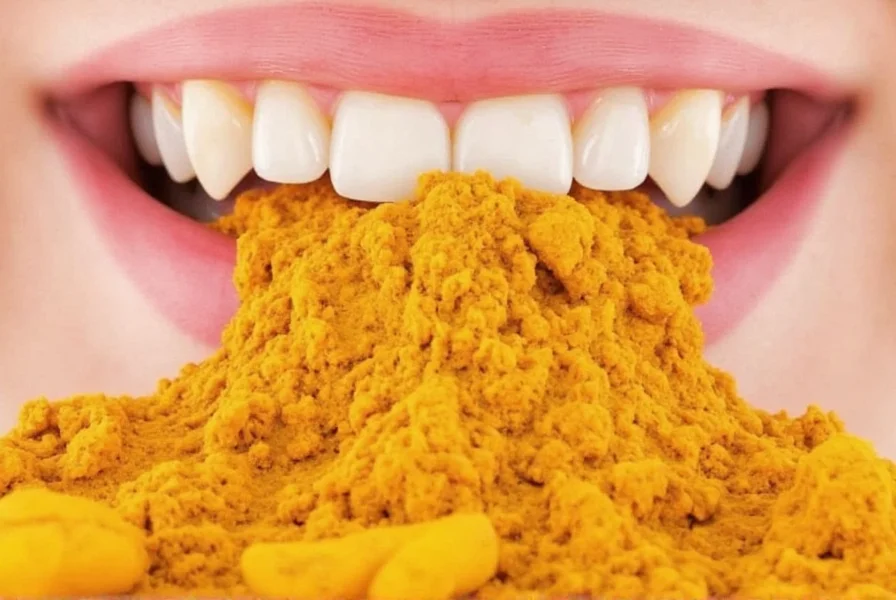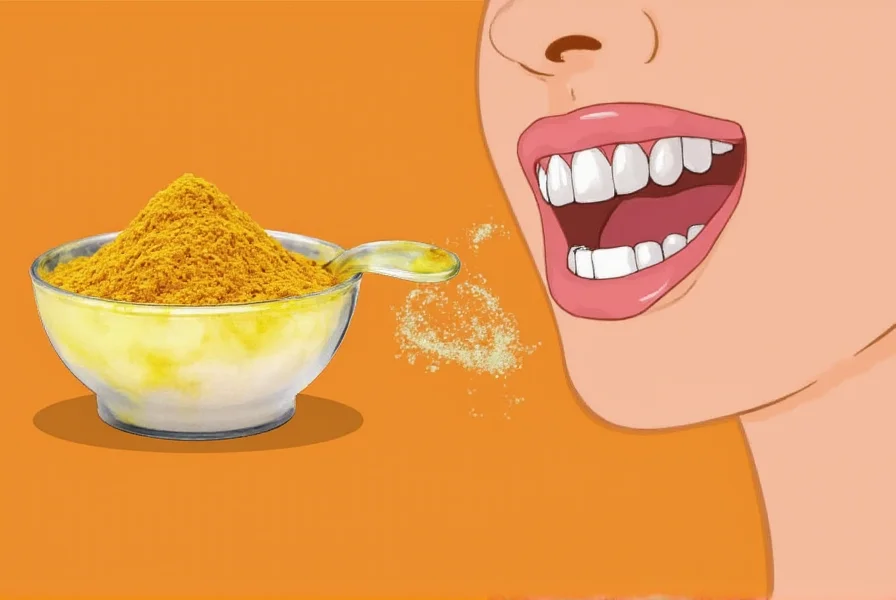Yes, turmeric can stain your teeth due to its intense yellow-orange pigment called curcumin. This natural compound binds easily to tooth enamel, particularly when consumed regularly in high concentrations through golden milk, supplements, or culinary use. The staining is typically temporary and can be managed with proper oral hygiene practices.
As turmeric's popularity continues to surge for its anti-inflammatory benefits, many health-conscious individuals are discovering an unexpected side effect: yellowish discoloration on their teeth. This vibrant spice, celebrated in both Ayurvedic medicine and modern wellness circles, presents a paradox for dental aesthetics. Understanding the relationship between turmeric consumption and tooth discoloration is essential for those incorporating this golden spice into their daily routines.
The Science Behind Turmeric Staining
Turmeric contains curcuminoids, with curcumin being the primary compound responsible for its distinctive color. This polyphenol has a strong affinity for binding to proteins in tooth enamel, creating what dentists call "extrinsic staining." Unlike intrinsic stains that penetrate beneath the enamel surface, turmeric causes surface-level discoloration that affects the outer layer of teeth.
Research published in the Journal of Indian Society of Periodontology confirms that natural pigments like those in turmeric can adhere to dental pellicle—the thin protein film that forms on teeth. This binding process occurs more readily when:
- Consuming turmeric in liquid form (golden milk, teas)
- Using turmeric supplements regularly
- Having naturally porous or weakened enamel
- Consuming turmeric alongside acidic foods that temporarily soften enamel
Turmeric vs. Other Common Staining Agents
How does turmeric compare to other well-known staining culprits? The table below shows relative staining potential:
| Substance | Staining Intensity (1-10) | Stain Type | Removal Difficulty |
|---|---|---|---|
| Turmeric | 7 | Extrinsic | Moderate |
| Coffee | 8 | Extrinsic | Moderate-High |
| Red Wine | 9 | Extrinsic | High |
| Black Tea | 6 | Extrinsic | Moderate |
| Blueberries | 5 | Extrinsic | Low-Moderate |
While turmeric ranks high for staining potential, its discoloration typically appears as a yellow tint rather than the brownish stains associated with coffee or tea. This distinction matters because yellow stains often respond better to standard whitening approaches.

Factors Influencing Turmeric Staining Severity
Not everyone who consumes turmeric experiences noticeable tooth discoloration. Several factors determine how significantly turmeric affects your smile:
Consumption Method
Liquid preparations like golden milk or turmeric tea create more contact time with teeth compared to incorporating turmeric into solid foods. Supplements in capsule form minimize direct contact but may still cause some staining if you open capsules or experience "turmeric burps."
Oral Hygiene Routine
Dental professionals emphasize that regular brushing (especially within 30 minutes of consumption), flossing, and using antiseptic mouthwash significantly reduce staining potential. Those with excellent oral hygiene often notice minimal discoloration even with daily turmeric use.
Enamel Condition
Teeth with microscopic cracks, natural grooves, or weakened enamel from acid erosion provide more surface area for curcumin to bind. Older adults and those with dental work may notice more pronounced staining.
Effective Prevention Strategies
Preventing turmeric stains requires understanding how the pigment interacts with your teeth. Consider these evidence-based approaches:
- Straw technique: When consuming turmeric beverages, use a straw positioned toward the back of your mouth to minimize contact with front teeth
- Timing matters: Consume turmeric-containing drinks with meals rather than alone to benefit from natural cleansing action of chewing
- Post-consumption rinse: Swish with plain water immediately after consuming turmeric products
- Delayed brushing: Wait 30 minutes after consuming acidic turmeric preparations before brushing to avoid damaging softened enamel
- Oil pulling: Some studies suggest coconut oil pulling may help reduce surface stains when practiced consistently
Removing Existing Turmeric Stains
If you've already noticed yellow discoloration from turmeric, several approaches can help restore your natural tooth color:
Professional Dental Cleaning
Dental hygienists can effectively remove surface stains during routine cleanings. Inform your dentist about your turmeric consumption so they can tailor their approach. Professional cleanings every six months typically prevent significant buildup.
At-Home Remedies
For mild turmeric discoloration, these methods show promise:
- Baking soda paste: Mix with water and brush gently 1-2 times weekly (overuse can damage enamel)
- Hydrogen peroxide rinse: Dilute 3% solution with equal parts water for a 30-second rinse
- Activated charcoal: Some users report success, though evidence remains limited and overuse may be abrasive

Benefits vs. Staining Concerns: Finding Balance
While turmeric staining presents a cosmetic concern, it's worth considering the substantial health benefits that make this spice so popular. Research in Advances in Experimental Medicine and Biology highlights turmeric's anti-inflammatory, antioxidant, and potential neuroprotective properties.
Dental professionals generally agree that the temporary cosmetic issue of staining shouldn't prevent someone from enjoying turmeric's health benefits. With proper prevention techniques, most people can incorporate turmeric into their wellness routine without significant dental consequences.
When to Consult Your Dentist
While turmeric stains are typically surface-level and manageable, consult your dentist if you notice:
- Stains that don't improve with standard oral hygiene
- Increased tooth sensitivity alongside discoloration
- Darkening that appears to be penetrating beneath the enamel surface
- Gum irritation or other oral health changes
Your dentist can determine whether discoloration stems from turmeric or indicates other dental issues requiring attention.
Conclusion
Turmeric's vibrant color comes with a trade-off: potential tooth discoloration. However, this natural staining effect is generally manageable with proper techniques. By understanding how turmeric interacts with tooth enamel and implementing strategic prevention methods, you can enjoy this powerful spice's health benefits without compromising your smile. Remember that consistent oral hygiene remains your most effective defense against turmeric stains, and most discoloration can be addressed through professional cleanings or gentle at-home approaches.
Frequently Asked Questions
Does turmeric permanently stain teeth?
No, turmeric typically causes extrinsic (surface-level) staining that doesn't permanently damage tooth enamel. With proper oral hygiene and occasional professional cleanings, most turmeric stains can be removed. The discoloration appears yellow rather than brown and generally responds well to standard whitening approaches compared to stains from coffee or tobacco.
How quickly does turmeric stain teeth?
Noticeable discoloration typically develops gradually with regular consumption over weeks or months. Occasional use rarely causes visible staining. Those consuming turmeric daily in golden milk, supplements, or culinary applications may notice subtle yellowing within 4-6 weeks, particularly if they don't implement preventive measures like immediate rinsing or strategic consumption timing.
Does turmeric stain dental work like veneers or crowns?
Turmeric can stain certain types of dental work, particularly composite resin materials used in fillings, veneers, and bonding. Porcelain and ceramic restorations resist staining better than composite materials. If you have dental work and consume turmeric regularly, discuss preventive strategies with your dentist to maintain uniform color across natural teeth and restorations.
Can I prevent turmeric stains by taking capsules instead of powder?
Capsules significantly reduce but don't eliminate staining risk. "Turmeric burps" (regurgitation of capsule contents) can still expose teeth to the pigment. To minimize risk with capsules, take them with plenty of water, avoid lying down immediately after consumption, and maintain good oral hygiene. For maximum prevention, swallow capsules with a full glass of water and follow with a water rinse.
Does the concentration of curcumin affect staining potential?
Yes, higher curcumin concentration directly correlates with greater staining potential. Standard turmeric powder contains about 2-8% curcumin, while supplements may contain 95% curcumin extracts. The more concentrated the curcumin, the more readily it binds to tooth enamel. When using high-concentration supplements, extra preventive measures like immediate rinsing and strategic consumption timing become particularly important.










 浙公网安备
33010002000092号
浙公网安备
33010002000092号 浙B2-20120091-4
浙B2-20120091-4